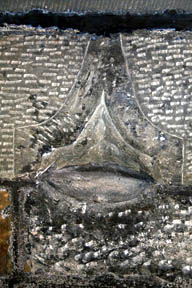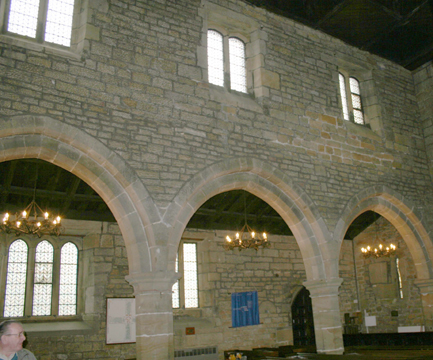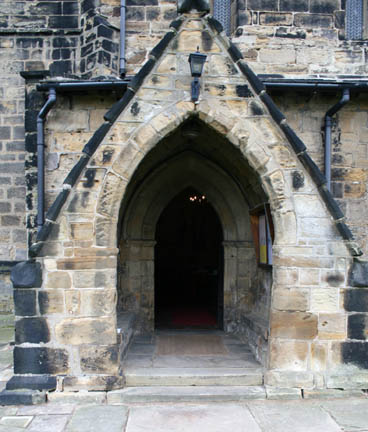Part 3
The Priors
of Nostell could well afford to maintain Felkirk because during the years
following the acquisition many gifts of land in and around Felkirk were
made by the successive landowners such as the de Montbegons the de
Scafton’s and de Hodrode’s. One of the last mentioned having the word
“Knight” as a suffix to his name. However, the 13th century saw
the enlarging of churches throughout Europe as a sort of religious fervour
to the glory of God., each one trying to be larger or more eye-catching
than its neighbour in the beauty of its design.
The building of churches did not stop the continual
wars that occurred in Europe, including England, as ultimate power was the
objective of all the kings who ruled their domains. In this country in
1280, Edward the first subdued the rebellious Welsh and no sooner had he
done this when trouble broke out with the Scots, which meant that he had
to march north and collect his army on the way. Thus Sir Walter Burton,
Knight of Kinsley was informed that he and men and arms would be needed
for the battles in Scotland. Being a religious person and rich he decided
that a chantry chapel should be built onto Felkirk church in order that
the community should go and pray for him and his men every day whilst they
were away fighting. So in 1285 the chapel was built on to the outside of
the south wall and becomes the first major change to the structu re. It
could not have been more than 8 or 10 feet wide or long but in the
interior was an alter and built into the wall can still be seen the
piscine where holy water was disposed of after communion. There was also a
carved hood and basin but unfortunately the chisel marks are all that
remains of this lovely piece of architecture. The section of the basin
complete with the drain hole and built into the wall can still be seen
(see photograph right).
re. It
could not have been more than 8 or 10 feet wide or long but in the
interior was an alter and built into the wall can still be seen the
piscine where holy water was disposed of after communion. There was also a
carved hood and basin but unfortunately the chisel marks are all that
remains of this lovely piece of architecture. The section of the basin
complete with the drain hole and built into the wall can still be seen
(see photograph right).
Throughout Western Europe the building and enlarging of churches reached
new heights during the second half of the 13th century and St
Peter’s was no exception as the Priors of Nostell decided that an aisle
should be added to the south side of the church incorporating the chantry
chapel. The south wall of the nave was demolished almost to the eaves and
an arcade of three old English style arches replaced it (see
photograph below). At the east end of this arcade a section of
outer wall still remains to be seen as it was built using the herring bone
pattern of masonry known as the Anglo Saxon style of stonework.
 This
was followed by the new outer wall and roof. The line of which can be
clearly seen above the lancet window at the west end on the outside of the
aisle. The corbelles, which supported the timber of the original roof at
the eaves, were left in place so the art of the early stonemasons can
still be seen on faces on the ends of each one. Could these carvings of a
person with his tongue out, one with a neatly trimmed beard and moustache,
another rather grotesque face and a fourth, who must be gurning, be
studies of the masons who built the south aisle or was it the fashion of
that period to carve them as a joke for posterity?
This
was followed by the new outer wall and roof. The line of which can be
clearly seen above the lancet window at the west end on the outside of the
aisle. The corbelles, which supported the timber of the original roof at
the eaves, were left in place so the art of the early stonemasons can
still be seen on faces on the ends of each one. Could these carvings of a
person with his tongue out, one with a neatly trimmed beard and moustache,
another rather grotesque face and a fourth, who must be gurning, be
studies of the masons who built the south aisle or was it the fashion of
that period to carve them as a joke for posterity?
It is also possible that there were three windows in the
new wall of the style popular in the 13th century with a
semi-circular head stone topping a space perhaps two
feet wide and three feet deep divided by a
perpendicular mullion and probably one or two horizontal glazing bars. The
reason being is that glass in sheets was of a poor quality and difficult
and expensive to manufacture. But by the same means artificial light in
the form of candles was also expensive and not environmentally friendly
due to the burning animal fats from which candles were made. Rush lights
were no better; as they too had to be dipped before they could burn and
produce light. Thus we have the reason why there are more windows on the
south side of a church than on the north side as this was the main source
of lighting the interior for many centuries.
The original door to the church
would have been dismantled and used to fit into the opening in the new
wall. It is not known whether it was a heavy single door of oak planks or
possibly a double opening door but whichever type it was it was decided
that it should have a porch built over it as this was becoming the regular
practise at this time. A church was the largest building, apart from a
castle, in any parish and consequently everyone went there not only to
practise religion but also to meet and talk to friends and relatives,
neighbours and the nobility. There were also notices and byelaws etc to be
read by those who could read and someone to read to those who could not –
a crier. Baptisms, weddings, funerals were also discussed at the church
door along with the parish tithes and allotment of lands for the following
year all of these whatever the weather so as one can guess a porch was a
blessing for those who got into its shelter. St Peter’s porch is not
overlarge (see photograph below right) but it is a very
substantial addition to the building and is quite unique in that the roof
is of carved stone slabs laid upon cha mfered
stone ribs and supported on the sidewalls, which in turn are buttressed to
give the added support to the very heavy roof.
mfered
stone ribs and supported on the sidewalls, which in turn are buttressed to
give the added support to the very heavy roof.
The jambs have each a hole and a groove cut
into them into which
poles could be fitted forming a barrier to animals that grazed in the
churchyard. The main door in situ is obviously modern and was perhaps hung
during the restoration of 1875 but the jambs on each side show
signs of erosion by weather so it is fair to
assume that they supported the original door a long time before the porch
was built. Note the 18th century graffiti initialled by the
‘artist’ on the left hand jamb.
About this time it
was decided that the chancel, which was narrower than the present one,
should have a sacristy built on to it at the northeast corner. This was
duly completed following the style of the porch - heavy stone slabs and
the roof supported by short stone walls buttressed as those on the porch.
The interior is completely different there are no visible ribs and the
ashlar slabs are laid in a tunnel vault style end to end to form a
ceiling. There is a window on the north end and a door opened onto the
sanctuary at the south end. This is the door that exists today with much
later fittings and repairs. This seems to be the conclusion of the first
phase in the enlargement of the church, which would have taken a few years
to complete. There are no records available so everything has to be
assessed by the architectural style e.g. Anglo Saxon, Old English,
Perpendicular, Tudor and etc with which to give an approximate date that a
certain section was built. However, give or take fifty years is, I think,
reasonable.